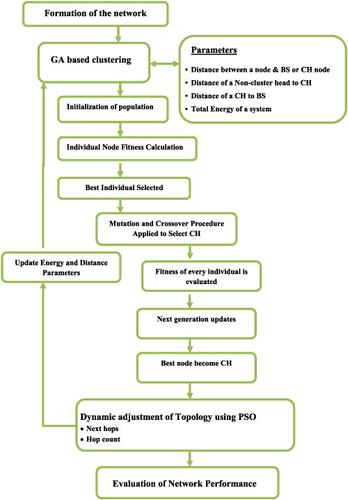当前位置:
X-MOL 学术
›
Int. J. Commun. Syst.
›
论文详情
Our official English website, www.x-mol.net, welcomes your
feedback! (Note: you will need to create a separate account there.)
New approach of GA–PSO‐based clustering and routing in wireless sensor networks
International Journal of Communication Systems ( IF 1.7 ) Pub Date : 2020-08-20 , DOI: 10.1002/dac.4571 Veena Anand 1 , Sudhakar Pandey 1
International Journal of Communication Systems ( IF 1.7 ) Pub Date : 2020-08-20 , DOI: 10.1002/dac.4571 Veena Anand 1 , Sudhakar Pandey 1
Affiliation

|
Wireless sensor networks (WSNs) not only have become an essential technology in the current scenario but also has been established as a core technology for many applications, like the Internet of Things (IoT). The drawback of limited energy resources in WSN creates the challenge of designing an energy‐efficient network topology and routing path. As these devices are generally not attended for any maintenance, such as battery replacement or charging, these resources need to be intelligently used. The paper represents a methodology for enhancing the lifetime of a network by using a genetic algorithm‐based clusteringand particle swarm optimization‐based routing in WSN. The best cluster head (CH) that collects the data from the remaining nodes is selected using a genetic algorithm, which considers distance and energy parameters. Further, the particle swarm optimization algorithm depends on optimal routing paths that are chosen for all relay nodes to send data to the Base Station (BS). The proposed procedure shows that the relay node supports and facilitates communication among the sink and CH, which enhances energy efficiency. Finally, the quality of service (QoS) of the WSNs is improved, due to which the system would survive longer. The results of simulated experiments show that the proposed approach significantly increases the lifetime of WSN and that energy consumption is reduced when compared with the existing protocols.
中文翻译:

无线传感器网络中基于GA–PSO的群集和路由的新方法
无线传感器网络(WSN)不仅已成为当前方案中的一项必不可少的技术,而且已被确立为许多应用程序(如物联网(IoT))的核心技术。WSN中能源资源有限的缺点带来了设计节能网络拓扑和路由路径的挑战。由于通常不对这些设备进行任何维护(例如更换电池或充电),因此需要智能地使用这些资源。本文介绍了一种在WSN中使用基于遗传算法的聚类和基于粒子群优化的路由来延长网络寿命的方法。使用遗传算法选择从其余节点收集数据的最佳群集头(CH),该算法考虑距离和能量参数。进一步,粒子群优化算法取决于为所有中继节点选择的最佳路由路径,以将数据发送到基站(BS)。所提出的过程表明,中继节点支持并促进宿和CH之间的通信,从而提高了能源效率。最终,改善了WSN的服务质量(QoS),从而使系统可以生存更长的时间。仿真实验结果表明,与现有协议相比,该方法显着提高了无线传感器网络的寿命,并降低了能耗。从而提高了能源效率。最终,改善了WSN的服务质量(QoS),从而使系统可以生存更长的时间。仿真实验结果表明,与现有协议相比,该方法显着提高了无线传感器网络的寿命,并降低了能耗。从而提高了能源效率。最终,改善了WSN的服务质量(QoS),从而使系统可以生存更长的时间。仿真实验结果表明,与现有协议相比,该方法显着提高了无线传感器网络的寿命,并降低了能耗。
更新日期:2020-10-05
中文翻译:

无线传感器网络中基于GA–PSO的群集和路由的新方法
无线传感器网络(WSN)不仅已成为当前方案中的一项必不可少的技术,而且已被确立为许多应用程序(如物联网(IoT))的核心技术。WSN中能源资源有限的缺点带来了设计节能网络拓扑和路由路径的挑战。由于通常不对这些设备进行任何维护(例如更换电池或充电),因此需要智能地使用这些资源。本文介绍了一种在WSN中使用基于遗传算法的聚类和基于粒子群优化的路由来延长网络寿命的方法。使用遗传算法选择从其余节点收集数据的最佳群集头(CH),该算法考虑距离和能量参数。进一步,粒子群优化算法取决于为所有中继节点选择的最佳路由路径,以将数据发送到基站(BS)。所提出的过程表明,中继节点支持并促进宿和CH之间的通信,从而提高了能源效率。最终,改善了WSN的服务质量(QoS),从而使系统可以生存更长的时间。仿真实验结果表明,与现有协议相比,该方法显着提高了无线传感器网络的寿命,并降低了能耗。从而提高了能源效率。最终,改善了WSN的服务质量(QoS),从而使系统可以生存更长的时间。仿真实验结果表明,与现有协议相比,该方法显着提高了无线传感器网络的寿命,并降低了能耗。从而提高了能源效率。最终,改善了WSN的服务质量(QoS),从而使系统可以生存更长的时间。仿真实验结果表明,与现有协议相比,该方法显着提高了无线传感器网络的寿命,并降低了能耗。











































 京公网安备 11010802027423号
京公网安备 11010802027423号